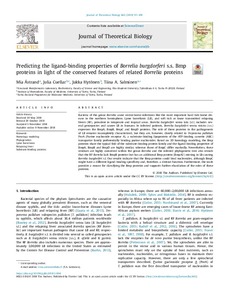Predicting the ligand-binding properties of Borrelia burgdorferi ss Bmp proteins in light of the conserved features of related Borrelia proteins
Åstrand Mia; Cuellar Julia; Hytönen Jukka; Salminen Tiina A.
Predicting the ligand-binding properties of Borrelia burgdorferi ss Bmp proteins in light of the conserved features of related Borrelia proteins
Åstrand Mia
Cuellar Julia
Hytönen Jukka
Salminen Tiina A.
Julkaisun pysyvä osoite on:
https://urn.fi/URN:NBN:fi-fe2021042720292
https://urn.fi/URN:NBN:fi-fe2021042720292
Tiivistelmä
Bacteria of the genus Borrelia cause vector-borne infections like the most important hard tick-borne disease in the northern hemisphere, Lyme borreliosis (LB), and soft tick or louse transmitted relapsing fevers (RF), prevalent in temperate and tropical areas. Borrelia burgdorferi sensu lato (s.l.) includes several genospecies and causes LB in humans. In infected patients, Borrelia burgdorferi sensu stricto (s.s.) expresses the BmpA, BmpB, BmpC and BmpD proteins. The role of these proteins in the pathogenesis of LB remains incompletely characterized, but they are, however, closely related to Treponema pallidum PnrA (Purine nucleoside receptor A), a substrate-binding lipoprotein of the ATP-binding cassette (ABC) transporter family preferentially binding purine nucleosides. Based on 3D homology modeling, the Bmp proteins share the typical fold of the substrate-binding protein family and the ligand-binding properties of BmpA, BmpB and BmpD are highly similar, whereas those of BmpC differ markedly. Nevertheless, these residues are highly conserved within the genus Borrelia and the inferred phylogenetic tree also reveals that the RF Borrelia lack BmpB proteins but has an additional Bmp protein (BmpA2) missing in LB-causing Borrelia burgdorferi s.l. Our results indicate that the Bmp proteins could bind nucleosides, although BmpC might have a different ligand-binding specificity and, therefore, a distinct function. Furthermore, the work provides a means for classifying the Bmp proteins and supports further elucidation of the roles of these proteins.
Kokoelmat
- Rinnakkaistallenteet [27094]
